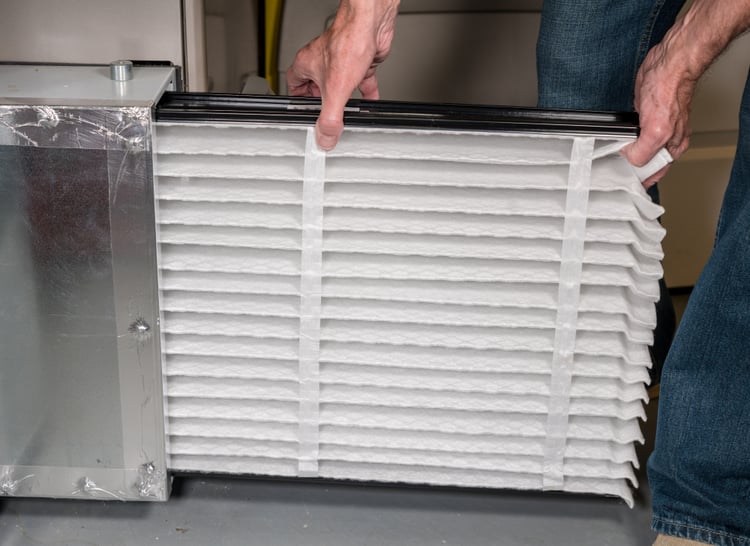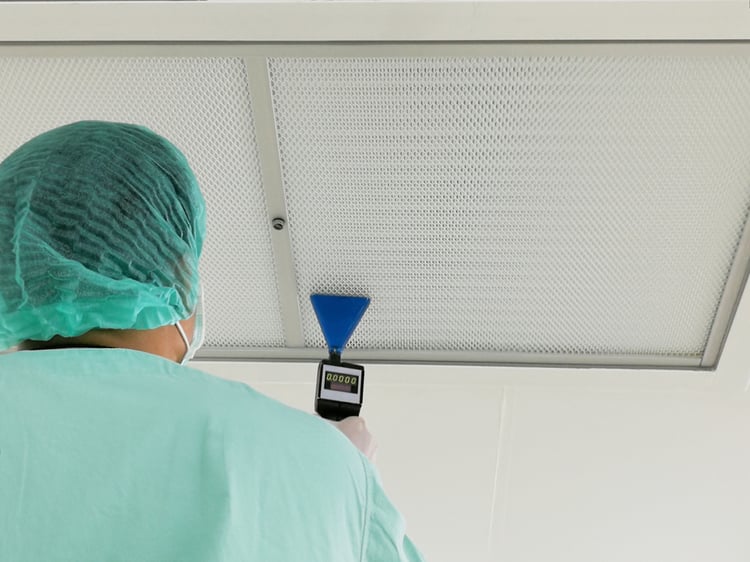Coronavirus Prevention with Air Filters: Understanding MERV and HEPA

Many coronavirus infections occur at short distances when infected persons sneeze or cough. However, the WHO has also warned about airborne transmission at longer distances, which happens when small droplets with the virus stay suspended in the air. ASHRAE provides many guidelines to help prevent the airborne transmission of COVID-19. One of their recommendations is to use air filters with at least a MERV 13 rating, or the superior HEPA rating when possible. This article will briefly describe each filter rating and its applications.
The professional opinion of an HVAC engineer is strongly recommended before attempting to upgrade any air filters. More efficient filters cause a higher pressure drop, and your air handling unit may not have enough capacity explains Ray Charles, founder of Household Air. There are three main options to improve air filtering in buildings:
- Upgrading to more efficient filters, while staying within the operating capacity of your ventilation system.
- Upgrading to an even higher filter efficiency, but also upgrading your ventilation system to overcome the additional pressure drop.
- Using portable air cleaners with high-efficiency filters. These can complement HVAC filter upgrades, or they can be used as an alternative when an upgrade is not possible.
Air filters are not only a prevention measure against airborne pathogens. They also capture inorganic pollutants like particulate matter, improving your indoor air quality in general. For even better results, filtering can be combined with an air purification method like Ultraviolet Germicidal Irradiation (UVGI). Air purification with UVGI not only kills viruses but also bacteria and mold spores.
Improve your indoor air quality with a filter upgrade, and lower the risk of infectious diseases.
Air filtering and other indoor air quality measures for COVID-19 are intended as a complement to the guidelines provided by health authorities: social distancing, handwashing, personal protective equipment (PPE), etc. These measures cannot be overlooked, even if you have the best air filtering and disinfection systems in the market.
MERV Filters: Minimum Efficiency Reporting Value

The Minimum Efficiency Reporting Value (MERV) is an effectiveness scale for air filters that was developed by ASHRAE in 1987. The scale goes from 1 to 16, where a larger number indicates a higher filter efficiency and the ability to capture smaller particles. The following table summarizes the average arrestance and applications of filters along the MERV scale and the typical particle size for which they are used.
| MERV | Avg. Arrestance | Particle Size Range | Applications |
| 1-4 | 60-80% | >10.0 microns | Minimum filtering for:
|
| 5-8 | 80-95% | 3.0-10.0 microns |
|
| 9-12 | >90-98% | 1.0-3.0 microns |
|
| 13-16 | >95-99% | 0.30-1.0 microns |
|
The MERV of a filter is determined with laboratory tests according to ASHRAE Standard 52.2. The test uses an aerosol generator and synthetic dust specified by ASHRAE, and particle counts are measured upstream and downstream from the filter. The testing procedure for the MERV rating uses 6 measurements and 12 particle sizes, which results in a total of 72 data points.
- To help prevent coronavirus infections in buildings, ASHRAE recommends upgrading air filters in HVAC systems to at least MERV 13.
- In cases where this is not possible, portable air cleaners with MERV 13 or better filters can be used.
- In residential settings, ASHRAE recommends upgrading typical 1-inch filters to MERV 13, and upgrading 2-inch filters to MERV 16. However, you should double-check with an HVAC engineer before proceeding.
- When using UVGI for in-duct air cleaning, ASHRAE recommends using at least MERV 8 filtering to complement the disinfection system.
A filter is only effective when air is moving through. For this reason, ASHRAE recommends increasing the operating schedules of ventilation systems, up to 24/7 if possible. More pollutants and germs are captured simply because more air moves through the filter.
HEPA Filters: High Efficiency Particulate Air

High Efficiency Particulate Air or HEPA has an even higher performance than MERV 16. While a MERV 16 filter captures >95% of particles in the entire test range (0.3-10.0 microns), a HEPA filter captures 99.97% of particles with a size of 0.3 microns. The filtering efficiency is even higher for particles larger or smaller than 0.3 microns. HEPA filters can capture many airborne germs, and also nonliving pollutants like fine particulate matter.
Since HEPA filters are so efficient, they cause a higher pressure drop than filters with MERV ratings. Many ventilation systems are not designed for HEPA, but these filters are available as portable air cleaners or vacuum cleaners
Given their high efficiency, HEPA filters are recommended for critical healthcare applications like anterooms, isolation wards, and COVID-19 patient rooms. When schools reopen after the coronavirus outbreak, ASHRAE also recommends a portable HEPA and UV air cleaner for each classroom, with at least two air rotations per hour.
Conclusion
Filtering is a mechanical air purification method, which means it works with living and nonliving particles. HEPA filters are the most efficient for residential or commercial use, followed by MERV 13-16 filters. However, the airflow restriction of these filters causes a pressure drop, and the ventilation system capacity must be considered before using them.
In cases where the ventilation system cannot handle a high-efficiency filter, you can use a portable air cleaner, while upgrading to the highest possible MERV rating with the existing capacity. Alternatively, you can upgrade the ventilation system itself, making it suitable for at least MERV 13 filters.
There are many types of HVAC systems, and each building is unique. To improve indoor air quality and prevent COVID-19 infections, the best starting point is an inspection by an experienced HVAC engineering firm.

Michael Tobias
Michael Tobias, the Founding Principal of NY Engineers, currently leads a team of 150+ MEP/FP engineers and has led over 4,000 projects in the US
Join 15,000+ Fellow Architects and Contractors
Get expert engineering tips straight to your inbox. Subscribe to the NY Engineers Blog below.

